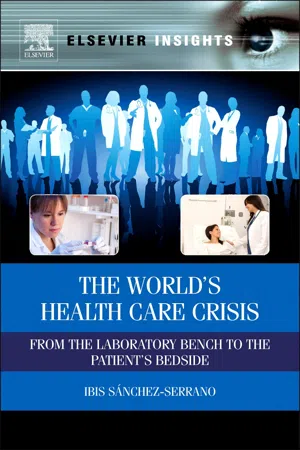
The World's Health Care Crisis
From the Laboratory Bench to the Patient's Bedside
- 296 pages
- English
- ePUB (mobile friendly)
- Available on iOS & Android
The World's Health Care Crisis
From the Laboratory Bench to the Patient's Bedside
About This Book
At present, human society is facing a health care crisis that is affecting patients worldwide. In the United States, it is generally believed that the major problem is lack of affordable access to health care (i.e. health insurance). This book takes an unprecedented approach to address this issue by proposing that the major problem is not lack of affordable access to health care per se, but lack of access to better, safer, and more affordable medicines. The latter problem is present not only in the United States and the developing world but also in countries with socialized health care systems, such as Europe and the rest of the industrialized world. This book provides a comparative analysis of the health care systems throughout the world and also examines the biotechnology and pharmaceutical industries.
- Examines the health care structure of the United States, Europe, and the third world, both separately and comparatively
- Offers primary source insight through in-depth interviews with pharmaceutical and health care industry leaders from around the world
- Carefully explains, in clear terms, the intricacies of the health care and pharmaceutical system and how these intricacies have led to the current crisis
- Offers concrete, comprehensive solutions to the health care crisis
Frequently asked questions
Information
The United States’ Leadership
Table of contents
- Cover image
- Table of Contents
- Front-matter
- Copyright
- Dedication
- How to Use
- Preface
- Acknowledgments
- Introduction
- 1. The World’s Health Care Crisis
- 2. The Health Care Crisis in Other Parts of the World
- 3. A Brief Commercial History of the Biopharmaceutical Industry up to the Year 2000*
- 4. The Biopharmaceutical Industry in the Twenty-first Century
- 5. Understanding Research and Development and Marketing in a Biopharmaceutical Company
- 6. The Pharmaceutical Regulators
- 7. The Academia–Industry Relationship
- 8. Translating Academic Innovation into Health Care Products
- 9. The Biotechnology World and Its Challenges
- 10. Causes of the Pharmaceutical Crisis
- 11. Wealth versus Poverty
- 12. Social Responsibility, Governmental Role, and Nongovernmental Organizations
- 13. Time for Reorganization
- Conclusion: Future Trends
- List of Terms
- Bibliography